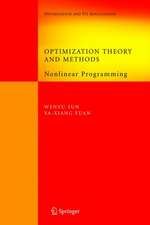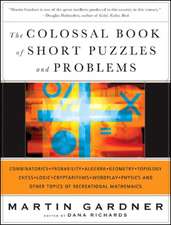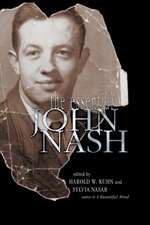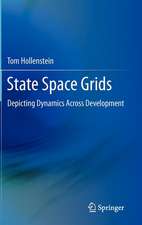Nonlinear Optimization with Financial Applications
Autor Michael Bartholomew-Biggsen Limba Engleză Paperback – 20 noi 2014
| Toate formatele și edițiile | Preț | Express |
|---|---|---|
| Paperback (1) | 639.59 lei 43-57 zile | |
| Springer Us – 20 noi 2014 | 639.59 lei 43-57 zile | |
| Hardback (1) | 645.79 lei 43-57 zile | |
| Springer Us – 3 ian 2005 | 645.79 lei 43-57 zile |
Preț: 639.59 lei
Preț vechi: 752.45 lei
-15% Nou
Puncte Express: 959
Preț estimativ în valută:
122.38€ • 128.12$ • 101.27£
122.38€ • 128.12$ • 101.27£
Carte tipărită la comandă
Livrare economică 07-21 aprilie
Preluare comenzi: 021 569.72.76
Specificații
ISBN-13: 9781489981196
ISBN-10: 1489981195
Pagini: 280
Ilustrații: XVII, 261 p.
Dimensiuni: 155 x 235 x 15 mm
Greutate: 0.4 kg
Ediția:2005
Editura: Springer Us
Colecția Springer
Locul publicării:New York, NY, United States
ISBN-10: 1489981195
Pagini: 280
Ilustrații: XVII, 261 p.
Dimensiuni: 155 x 235 x 15 mm
Greutate: 0.4 kg
Ediția:2005
Editura: Springer Us
Colecția Springer
Locul publicării:New York, NY, United States
Public țintă
ResearchDescriere
The book introduces the key ideas behind practical nonlinear optimization. Computational finance – an increasingly popular area of mathematics degree programs – is combined here with the study of an important class of numerical techniques. The financial content of the book is designed to be relevant and interesting to specialists. However, this material – which occupies about one-third of the text – is also sufficiently accessible to allow the book to be used on optimization courses of a more general nature. The essentials of most currently popular algorithms are described, and their performance is demonstrated on a range of optimization problems arising in financial mathematics. Theoretical convergence properties of methods are stated, and formal proofs are provided in enough cases to be instructive rather than overwhelming. Practical behavior of methods is illustrated by computational examples and discussions of efficiency, accuracy and computational costs. Supporting software for the examples and exercises is available (but the text does not require the reader to use or understand these particular codes). The author has been active in optimization for over thirty years in algorithm development and application and in teaching and research supervision.
Cuprins
List of Figures List of Tables Preface 1: PORTFOLIO OPTIMIZATION 1. Nonlinear optimization 2. Portfolio return and risk 3. Optimizing two-asset portfolios 4. Minimimum risk for three-asset portfolios 5. Two- and three-asset minimum-risk solutions 6. A derivation of the minimum risk problem 7. Maximum return problems2: ONE-VARIABLE OPTIMIZATION 1. Optimality conditions 2. The bisection method 3. The secant method 4. The Newton method 5. Methods using quadratic or cubic interpolation 6. Solving maximum-return problems3: OPTIMAL PORTFOLIOS WITH N ASSETS 1. Introduction 2. The basic minimum-risk problem 3. Minimum risk for specified return 4. The maximum return problem4: UNCONSTRAINED OPTIMIZATION IN N VARIABLES1. Optimality conditions2. Visualising problems in several variables3. Direct search methods4. Optimization software and examples5: THE STEEPEST DESCENT METHOD1. Introduction 2. Line searches3. Convergence of the steepest descent method4. Numerical results with steepest descent5. Wolfe’s convergence theorem6. Further results with steepest descent6: THE NEWTON METHOD1. Quadratic models and the Newton step 2. Positive definiteness and Cholesky factors3. Advantages and drawbacks of Newton’s method4. Search directions from indefinite Hessians5. Numerical results with the Newton method7: QUASINEWTON METHODS 1. Approximate second derivative information 2. Rauk-two updates for the inverse Hessian3. Convergence of quasi-Newton methods4. Numerical results with quasi-Newton methods5. The rank-one update for the inverse Hessian6. Updating estimates of the Hessian8: CONJUGATE GRADIENT METHODS 1. Conjugate gradients and quadratic functions2. Conjugate gradients and general functions3. Convergence of conjugate gradient methods4.Numerical results with conjugate gradients5. The truncated Newton method9: OPTIMAL PORTFOLIOS WITH RESTRICTIONS1. Introduction 2. Transformations to exclude short-selling3. Results from Minrisk2u and Maxret2u 4. Upper and lower limits on invested fractions10: LARGER-SCALE PORTFOLIOS1. Introduction 2. Portfolios with increasing numbers of assets3. Time-variation of optimal portfolios4. Performance of optimized portfolios11: DATA-FITTING AND THE GAUSS-NEWTON METHOD1. Data fitting problems2. The Gauss-Newton method3. Least-squares in time series analysis4. Gauss-Newton applied to time series5. Least-squares forms of minimum-risk problems6. Gauss-Newton applied to Minrisk1 and Minrisk212: EQUALITY CONSTRAINED OPTIMIZATION1. Portfolio problems with equality constraints2. Optimality conditions3. A worked example 4. Interpretation of Lagrange multipliers5. Some example problems13: LINEAR EQUALITY CONSTRAINTS1. Equality constrained quadratic programming2. Solving minimum-risk problems as EQPs3. Reduced-gradient methods4. Projected gradient methods5. Results with methods for linear constraints14: PENALTY FUNCTION METHODS1. Introduction2. Penalty functions3. The Augmented Lagrangian4. Results with P-SUMT and AL-SUMT5. Exact penalty functions15: SEQUENTIAL QUADRATIC PROGRAMMING1. Introduction2. Quadratic/linear models3. SQP methods based on penalty functions4. Results with AL-SQP 5. SQP line searches and the Maratos effect16: FURTHER PORTFOLIO PROBLEMS1. Including transaction costs 2. A re-balancing problem3. A sensitivity problem17: INEQUALITY CONSTRAINED OPTIMIZATION1. Portfolio problems with inequality constraints2. Optimality conditions3. Transforming inequalities to equalities 4. Transforming inequalities to simple bounds5. Example
Recenzii
From the reviews:
"The book is intended for readers who have an understanding of linear algebra, and the Taylor mean value theorems in several variables. It presents numerical approaches to nonlinear optimization which typically have been applied for 30-40 years to practical problems in science and engineering. … Summing up, one could say that the author had an interesting idea to present the classical algorithmic methods while teaching contemporary portfolio theory." (Leszek S. Zaremba, Zentralblatt MATH, Vol. 1083 (9), 2006)
"This book is a timely and very useful addition to the literature on practical mathematical optimization. … Indeed, the outstanding and almost unique aspect of the work is the thorough integration of the methods with application … . The text is very readable and will be easy to teach from. The passion of the author for, and his fascination with, optimization are conveyed to the reader. His mathematically flavored poems, scattered throughout the text, entertain and amuse … ." (Jan A. Snyman, SIAM Review, Vol. 48 (1), 2006)
"This book contains many computational examples demonstrating the practical behavior of the proposed methods and their application to practical financial problems." (Mathematical Reviews, Zimmermann, K.)
"The book is intended for readers who have an understanding of linear algebra, and the Taylor mean value theorems in several variables. It presents numerical approaches to nonlinear optimization which typically have been applied for 30-40 years to practical problems in science and engineering. … Summing up, one could say that the author had an interesting idea to present the classical algorithmic methods while teaching contemporary portfolio theory." (Leszek S. Zaremba, Zentralblatt MATH, Vol. 1083 (9), 2006)
"This book is a timely and very useful addition to the literature on practical mathematical optimization. … Indeed, the outstanding and almost unique aspect of the work is the thorough integration of the methods with application … . The text is very readable and will be easy to teach from. The passion of the author for, and his fascination with, optimization are conveyed to the reader. His mathematically flavored poems, scattered throughout the text, entertain and amuse … ." (Jan A. Snyman, SIAM Review, Vol. 48 (1), 2006)
"This book contains many computational examples demonstrating the practical behavior of the proposed methods and their application to practical financial problems." (Mathematical Reviews, Zimmermann, K.)
Textul de pe ultima copertă
• The book introduces the key ideas behind practical nonlinear optimization.
• Computational finance—an increasingly popular area of mathematics degree programmes—is combined here with the study of an important class of numerical techniques.
• The financial content of the book is designed to be relevant and interesting to specialists. However, this material—which occupies about one-third of the text—is also sufficiently accessible to allow the book to be used on optimization courses of a more general nature.
• The essentials of most currently popular algorithms are described and their performance is demonstrated on a range of optimization problems arising in financial mathematics.
• Theoretical convergence properties of methods are stated and formal proofs are provided in enough cases to be instructive rather than overwhelming.
• Practical behaviour of methods is illustrated by computational examples and discussions of efficiency, accuracy and computational costs.
• Supporting software for the examples and exercises is available (but the text does not require the reader to use or understand these particular codes).
• The author has been active in optimization for over thirty years in algorithm development and application and in teaching and research supervision.
Audience
The book is aimed at lecturers and students (undergraduate and postgraduate) in mathematics, computational finance and related subjects. It is also useful for researchers and practitioners who need a good introduction to nonlinear optimization.
• Computational finance—an increasingly popular area of mathematics degree programmes—is combined here with the study of an important class of numerical techniques.
• The financial content of the book is designed to be relevant and interesting to specialists. However, this material—which occupies about one-third of the text—is also sufficiently accessible to allow the book to be used on optimization courses of a more general nature.
• The essentials of most currently popular algorithms are described and their performance is demonstrated on a range of optimization problems arising in financial mathematics.
• Theoretical convergence properties of methods are stated and formal proofs are provided in enough cases to be instructive rather than overwhelming.
• Practical behaviour of methods is illustrated by computational examples and discussions of efficiency, accuracy and computational costs.
• Supporting software for the examples and exercises is available (but the text does not require the reader to use or understand these particular codes).
• The author has been active in optimization for over thirty years in algorithm development and application and in teaching and research supervision.
Audience
The book is aimed at lecturers and students (undergraduate and postgraduate) in mathematics, computational finance and related subjects. It is also useful for researchers and practitioners who need a good introduction to nonlinear optimization.
Caracteristici
Contains state-of-the-art research findings
Includes supplementary material: sn.pub/extras
Includes supplementary material: sn.pub/extras












